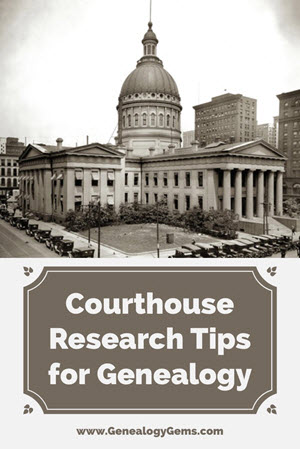These 4 tips for courthouse research will help you get the most out of your searches for U.S. courthouse records.
Finding your family history in a county courthouse can be a real thrill. But courthouses can be a little…overwhelming. Confusing. Intimidating. And frustrating, if you feel like you’re wasting the little bit of time you have there. So check out these four tips for getting the most out of your next trip to the courthouse!
1. Know what questions you hope to answer.
What specifically do you hope to learn at the courthouse? Examples of answers you want might be: “I want to identify every child this couple had, I want to determine which years they lived here, I want to know more about land they owned, I want to confirm vital events for these three people, I heard there was a scandal and I want to know if there are court records.” These are the kinds of questions you might successfully research at a courthouse.
2. Learn what resources exist to answer those questions.
Several different kinds of courthouse records can answer our genealogical questions: vital records, deeds, tax records, and wills, probate or estate records, tax or plat maps, road and survey books and more.
Dig around on county offices websites to see what records are at the courthouse. Watch for mention of or links to older records that may no longer be in the offices. Also, Google the name of the county and the word “archives” and see if there is an official archive. After you’ve done some online research, call the appropriate county office (Recorder, Probate, etc) with your remaining questions. Like, what vital or property records exist for a certain time period, or are there delayed birth records, etc.
3. Read up on using complicated record types before you go.
Usually we are pressed for time when we’re researching on-site. Don’t waste that time learning what grantor and grantee indexes are, the differences between different types of deeds, or what a letter of administration is. Learn these ahead of time.
The best way to do that is with some focused tutorials and classes. You can teach yourself what various types of documents look like by browsing them on your favorite genealogy website or by indexing (click here to read about different indexing opportunities). But these self-guided record tours won’t teach you the ins and outs of working with and understanding these records.
4. Learn what you can on the spot.
Once you find something with your ancestor’s name on it at the courthouse, of course you’ll be thrilled! Don’t just make a copy and tuck it away. Try to digest and interpret what it tells you. Follow up whatever you learn in that document, because maybe it brings up another question you can answer while you’re still there. This is another reason it pays to be prepared before you head to the courthouse–so again, learn all you can before you go.
 Thanks for sharing these practical tips with your genealogy friends and on your society Facebook pages. It’s easy, it’s free and you may help someone else learn a much-needed skill! YOU are a gem!
Thanks for sharing these practical tips with your genealogy friends and on your society Facebook pages. It’s easy, it’s free and you may help someone else learn a much-needed skill! YOU are a gem!
Disclosure: This article contains affiliate links and Genealogy Gems will be compensated if you make a purchase after clicking on these links (at no additional cost to you). Thank you for supporting Genealogy Gems!




